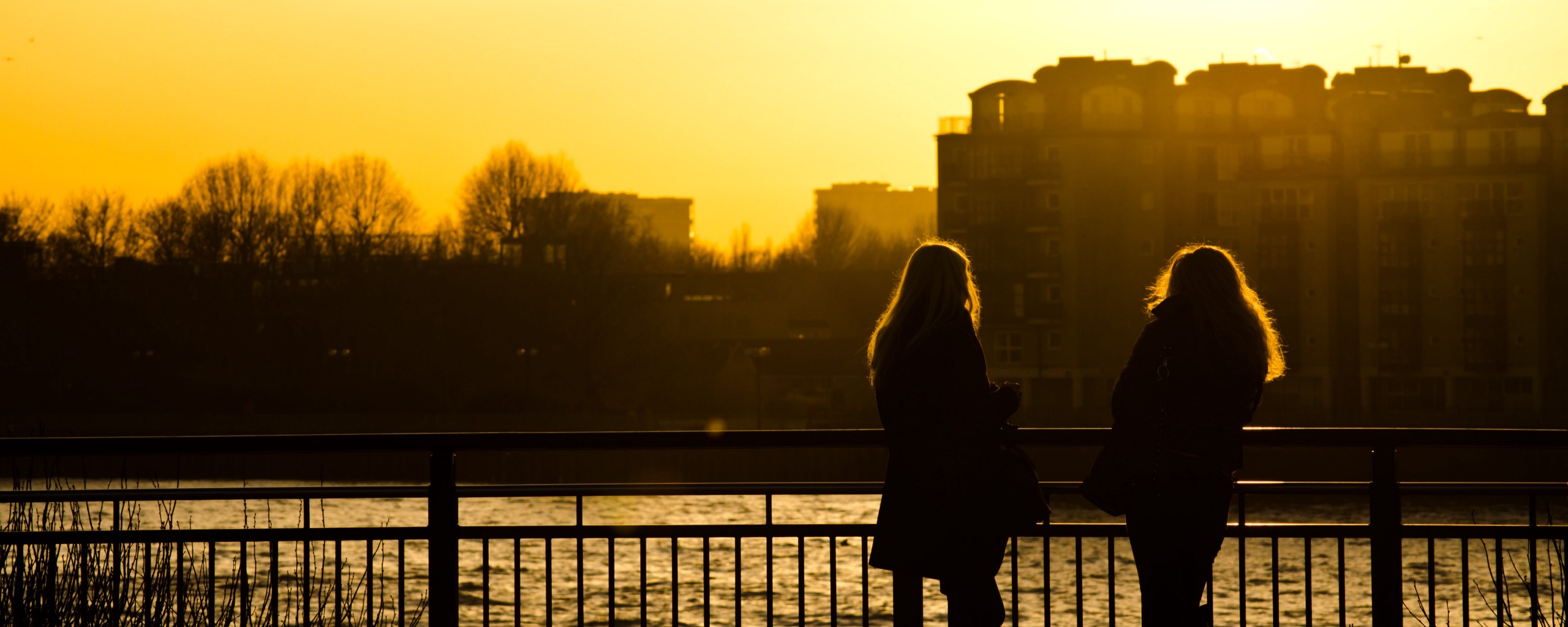

If we could trace the foot traffic of women in public city spaces, we would notice there are certain places they do not tread.
Women are told to avoid alleys and going out at night alone, to keep their keys in their hands–poised and ready to use them as a weapon like Wolverine–when walking to their cars. The fear of violence is so often projected onto the bodies of women that it’s become their responsibility not to get hurt. This is not a natural thing–it’s a socially learned behavior, where the geography of their absence reveals their fears.
When looking at what, exactly, women should expect when in public, we find an anticipation of violence. Women (and people who care for them) are constantly reminding one another that they should be careful when walking alone in the city. The feminist philosopher Laura Hengehold calls this loneliness: the widespread assumption that if a woman is alone, she must be lonely, and if she’s lonely, then she must need company–typically, a man’s. This loneliness feeds into our urban environments, infusing them with unnecessary fear. Harassers have come to assume that if a woman is alone, she wants to be spoken to–to have some company. Hengehold also points out that a lone woman walking in public is made to feel like they would be abandoned the moment she’s in an emergency situation, such as an assault, and actually needs help.
While statistically violence against women is more likely to happen in private, it’s public space we continue to fear. Performance art suggests that taking on a demeanor of utter confidence–and even flamboyant boldness–is one way that women can reclaim lost space for themselves. This boldness is described as “solitude” and instead of loneliness, women can take on this attitude when walking down the streets of a city.
Or, even better–hypersolitude. Let me explain.
This idea comes from Hille Koskela, a feminist geographer, who argues that: “If women dress up to be part of the urban spectacle, they oppose their erasure and reclaim urban space.” Hypersolitude is the idea that a woman can be radically solitary in public space–not dismissing her vulnerability, but embracing it and making it a source of power.
Three performance artists–Valie Export, Sophie Calle, and Adrian Piper–each perform as lone women in the streets of cities, illustrating exactly how powerful hypersolitude can be.
Austrian artist Valie Export, in her 1968 performance Tapp und Tastkino (Tap and Touch Cinema), tried to show that a woman’s body is more than just an object to be stared at–by wearing a miniature theater around her upper body and asking people, mostly men, to reach through a curtain and touch her breasts.
By challenging the public to engage with an actual woman instead of just the image of one, Export directly addresses the voyeuristic nature of the male gaze. It’s a tactile experience–they feel her and see her as a person–and Export both controls and directs everything about it, disrupting the social expectations of how men and women interact with each other in public space, reclaiming her own body in the process.
Then there’s French artist Sophie Calle. Part of the reason women are seen as vulnerable comes from the idea that they’re delicate, breakable, and victimized. In Suite Vénitienne, Calle stalked an acquaintance for twelve days in 1980 across Europe, reversing the usual expectation of a man stalking a woman. In trailing him through the city and photographing him at every stop, Calle switches the narrative that tells women they are constantly at risk of being targeted, followed, or worse. Her autonomy also becomes tied up with this white male stranger; he leads her into spaces he thinks he’s entering alone, and in the process Calle ends up traveling on a masculine path through the city–the opposite of the kinds that women would choose out of fear.
Similarly, in cities with lots of people living closely together, differences can cause conflict. The terms “stranger danger” and the “bystander effect,” for example, were both inspired by singular incidents of kidnap and brutal assault, and have become specifically linked with the idea that women and children in particular are unsafe in cities.
In this vein, American artist and philosopher Adrian Piper is interested in the ways that certain public spaces are codified by race and gender. Throughout her career, she has chronicled and radically responded to the ways in which she is received as someone who identifies as a black woman–but one who is often mistaken for white at parties and in public.
In her “Catalysis” series in 1971, Piper’s public performances took the form of direct confrontation with her “audience” on the streets of New York City. She rode the subway with a towel shoved in her mouth during rush hour; went shopping at Macy’s with “Wet Paint” painted on her shirt; and filled her purse with ketchup, pulling items from it and smearing her body with sauce. She deliberately made herself vulnerable, and tried to repulse people, in turn challenging the idea of public space altogether–after all, if it’s meant to be for everyone, then why are there still rules about who is and isn’t tolerated?
Piper’s hypersolitude is obvious–she makes her own body an object, mutilates it, and then forces people to confront it, inevitably causing confusion, disgust, and fear in them. There’s no way to avoid confrontation about the ways in which etiquette and social norms play a part in making women feel unsafe in public spaces.
In each of these performances, there’s a woman, acting alone, with her body either on display, confronting a crowd, or at risk of violence. But in each, Export, Calle, and Piper use their vulnerability as a way to reinvent the narratives we hold about city living. Women shouldn’t have to live in fear walking down a city street, and it will take more than a significant shift in attitude and posture to create a less sexist, built environment.

While there are lots of studies that look at how we organize our cities and house people, it’s just as important to consider how the spaces we live in influence how we act around each other and how we navigate them–especially as they continue to develop, decay, and gentrify. It directly influences the kinds of people we expect to see in a place, and the kinds of people we’re surprised to see.
Take the saying that “a woman’s place is in the home,” another cliché implying that a woman, alone in a city, is out of place. There’s a binary in our cities between the urban and the suburban, one that has its roots in the Industrial Revolution–slum housing inspired strikes, which in turn made planners build better housing on the edges of cities for skilled white men and and their families. It led to happier, more docile (and, for bosses, more profitable) work forces in the late 19th century–but the flip side is that immigrant families ended up living in the old, cheaper slum houses, even when working the same jobs as their white counterparts.
The physical distance between the new suburbs and the old city centers also led to a physical distance between the types of work men and women were expected to do–”skilled” labor was what happens in the city, but the suburbs were for women’s (unpaid) domestic work. “[The private suburban house] was the commodity par excellence, a spur for male paid labor and a container for female unpaid labor,” argues urban historian Dolores Hayden. Homeownership pushed consumerism (because you need one of everything, right?) and in turn drove the economy.
Between 1890 and 1970, though, more women joined the labor force, increasing their visibility in urban environments–the majority of them married white women with families. Access to education meant college cities were flooded with single women, but as economist Claudia Goldin has pointed out, schooling was mainly a benefit for white women. Meanwhile, women of color did as much work as married white women but weren’t likely to be seen in the city. “Differences in family life cycles, discrimination in the housing and labor markets, and measurement problems in valuing part-time labor are among the suggested explanations for this intriguing finding,” she writes.
So, it’s not enough on its own to be more visible as a woman in the city–there needs to be a kind of boldness in her presence for a large-scale social adjustment to occur–the kind that comes from confrontation. It’s time for hypersolitude, then. Owning public space as a woman and allowing them to do so.
This is still a difficult thing for many women to do. Street harassment is too often seen as harmless–when it’s a reminder of the entitlement that men have in public spaces, and of who isn’t welcome. So much sexual harassment in public comes from the idea that women are unsafe without a male companion in the dirty, wild streets of the city. But it’s hardly just that–women get yelled at about their bodies without provocation all the time. It’s a violation of public privacy, sexualizing a woman without her consent.
Even though hypersolitude is just an idea inspired by art performance, it pushes the boundaries of what is possible for women in urban spaces, and helps us to envision what a more equitable city might be like.


How We Get To Next was a magazine that explored the future of science, technology, and culture from 2014 to 2019. This article is part of our Metropolis section, on the way cities influence new ideas–and how new ideas change city life. Click the logo to read more.
